
|
 |

|
 |
A performance giving voice to the voiceless - Dr. S. D. Desai e-mail: sureshmrudula@yahoo.co.in February 8, 2014  Naomi Deira No need for contrasts of sounds. No noise for a hush to descend. No lull at the end of a storm. Silence flows all though the performance, carrying the anguish of people who even while they were in the mainstream used to remain on its margins leading a miserable existence. Skimmed off like scum, they are thrown a long distance away in a stinking area. Displaced is a softer word. The title of the production nearly proclaims them damned. Art expresses pain more poignantly than the reality staring in your face does. It pinpoints suffering to the exclusion of the paraphernalia of reality. In this unusual and telling multimedia production The Damned, the concluding compact one-hour piece in Darpana Academy's trilogy on displacement at InterArt 2013-14, the 38th Vikram Sarabhai International Arts Festival, demonstrates a modern process of rasanishpatti through an ensemble of choreography, videoscapes, music, sounds, silences, lights and even costumes. Prompted by the disturbing sudden disappearance of groups of people working on the riverside, turned into a riverfront now, and finding them officially 'resettled' in an inhabitable area far away, The Damned seeks to create empathy among those who have the voice in the 'sanitized' mainstream of life for those who have no voice and suffer silently. In keeping with the concept of rasanishpatti in Indian aesthetics, the painful experience the piece creates becomes sadharanikrit (universalized). With no text, which could tend to make the central event specific, the experience comes across as one shared by those displaced by war, riots, industrialization, natural calamities and the like. Social concern and art combine here at a pretty high level of aesthetics. Those who know Mallika Sarabhai and her commitment would see her as the moving force. Naomi Deira, the young choreographer from London, has put her head and heart into creating what she calls 'a platform for unheard voices' across the globe to express without words their anguish in finding even their modest dreams suddenly shattered and emotions getting into turmoil through choreography. Naomi gets the performers of Darpana so infused with intensity that they were seen hugging one another with tears at the end in something of an inconsolable state of mind. Being a temporal art, unlike literature, dance vanishes the moment it comes into being. Yadavan Chandran partly makes up for this limitation. He gets moments of high emotional intensity frozen in time with the camera charged with his own craft and commitment. The focus of the performance remained on the cause. Anonymity about its makers enhanced its impact. No names were announced at the end. Someone was heard saying it was Naomi's conscious decision. (The trilogy of performances is scheduled to travel to the capital next month.) The interview with Naomi Deira below seeks to unravel her approach and process: 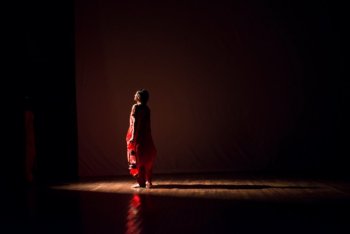 How did you go about working for The Damned? It involved research both in the library and in the field, I suppose. I was given the topic of displacement by Mallika Sarabhai as creative stimulus for the piece in March 2013. I began to research the meaning of displacement and its effects globally and I narrowed the research into what it meant within India. After delving into the stories of those affected by displacement, I focused my attention on the topic of internal displacement. Beyond researching via varying forms of media and written documentation, we decided it was important as a company to visit those affected so that the stories and themes we were exploring would become tangible for all of us. It was very influential and possibly the most important point in the process to fully understand the extent to which the topic we were exploring was having an effect on those experiencing it firsthand. This experience of visiting the displaced fed into the rehearsal process and gave a solid context from which both the performers and I could draw from in taking these ideas and translating those themes into the resulting production. I was given creative freedom and trust was placed in me as an artist by Mallika, which created the ground work for a fruitful creative process. Western and Indian dance forms are two different genres. In one, physicality is stretched to its limit. In the other, there is exploration within. The process of synthesizing the complementary strengths must have been as much challenging as exciting. I never look at things in regard to how they are different but instead at what connect us. Why is it that we always focus on the difference in things and never ask instead: what are the connections within the forms? Or, what connects us? We all use the same instrument 'the human body' and for me it's all about understanding how an instrument works and the emotions within. 70% of my work is letting my performers understand principles of what connects us. Would you give some details about the way individual and group scenes were created and captured by the camera? The Damned is not only performed by the professional dance company but includes a community engagement project, where members of the local community are invited to form part of us as on-stage performers. The community engagement aspect is an integral part of the piece, bridging the storytelling of dance with the grassroots reality of the issue. Episode III of the performance is focused on the protests against dam construction in India. Those displaced have lost their livelihoods, submerged by the rising waters of man-made decisions. They voice their pleas, but it falls on deaf ears. They surrender to silent protest, hoping that echoes of their silent screams will bring attention and change. Central in this episode is the visuals that have been filmed by Yadavan Chandran. We fight in silence, for there is power in peace. Though we are battered, we seal our lips to bottle our anger and stand in silence as pillars of a common voice. We invite viewers to join us in this moment of silence and give their time to voice with us our plea, for there is strength in numbers. For sixteen days they stood in rising waters to protect their homes and livelihoods, so join us in these sixteen minutes as we all have something to fight for and in silence we fight together. During my research, I came across film footage of the Ghogal Village protests against construction of the Onkareshwar Dam in Madhya Pradesh. Though initially I was referencing to the film footage as inspiration for the dance material, I realized what the power of the images presented would have, if it were incorporated into the production itself. It wasn't just research anymore. The word 'displacement' had a face and not just one. I started thinking I can't just create a show with seven beautiful dancers. If I want the audience to go through an experience, I need to find a way to bring this to the stage and let them feel the same as I did during my research period. After talking with Yadavan Chadran (filmmaker) about the concept, we decided that we would recreate the scene, having all cast members sit in water for hours. The hours Yadavan and his team have spent in the water is a testament to the artistic contributions they have infused in the development of the production. The quality of the visuals has taken The Damned to a place above and beyond what I could have wished for. 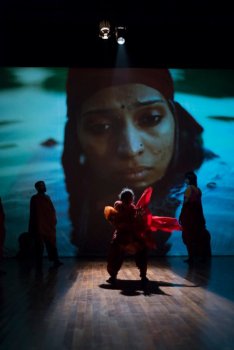
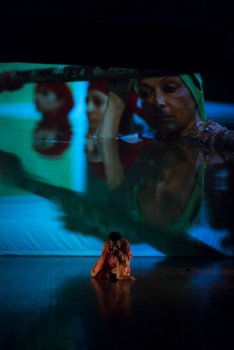
In a segment, the performers express their turmoil through charged convulsive movement and intensely anguished looks. In another, some of them are in chest-deep and neck-deep water as protesters on the screen with pain frozen on their faces. How did you get them to do both these segments? The best person to answer this question is my creative assistant Kiraly Saint Claire. He says: "We explored varying themes surrounding the effects of displacement, some of which dealt with the emotional responses associated with having lost something as dear as their sense of home and belonging. In assisting Naomi, I related to some of the techniques of Stanislavsky in his methods of naturalism for actors where he speaks about emotional memory in which the performers, though they may not have experienced in their own lives the situations explored in the narrative, they can still draw emotionally from experiences from their past where they engaged with relative emotions. With this in mind, performers can associate for example the emotion of pain of having lost a loved one through death with the pain of having suddenly lost all their belongings and livelihood. We discussed in detail during the process stories from those who had been displaced and as well visited a displaced community. This gave a base for the emotional journey the performers go through." How did you integrate inputs of music, sounds and silences into the performance? My heart warms when I think of the collaboration with Jayan Nair, the composer of The Damned. It has been such a pleasure to work creatively with such an amazing artist with a supportive and infectious passion for what he and his musicians do. I would find reference for sounds and feels that I'm looking for and brief Jayan. Having such a gifted composer supporting me on this journey has truly been a blessing. He made the story come alive. What helps you strike a balance between aesthetics and a message to the contemporary world? The aesthetics of The Damned gives the audience a three-dimensional experience within which the message is explored. The question always arises - how much do you reveal and how much do you conceal? How much space do you allow for the audience to create their own interpretation of a piece? So there's constantly a dialogue between the narrative and aesthetics of the work to set accessible means for modern audiences to engage with. 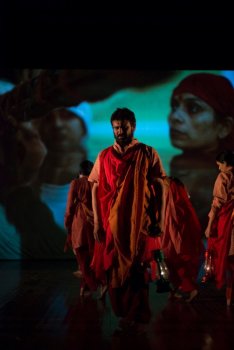
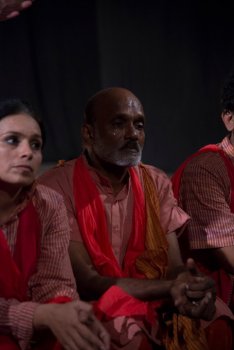
Would you say you got 100% of what you expected from your performers? Did you feel something was yet left unachieved? The dancers gave more than a hundred percent in engaging with and executing what I asked of them during the creative process as well as on stage in the live performances. There is always the looming sense of did I do enough and can I do more? I'm a perfectionist by nature and I constantly question if I can and will ever be satisfied to the point of considering one of my works 'finished.' Within art, the creation and thinking never stops and regardless of what point I am within the development or performance of a production, ideas continually arise but I find comfort in the fact that what has been done resonates with those who engage with it. Have you had experience of working on such other projects of social significance? The Damned has been a starting point for me in developing and exploring the use of the arts as a means for providing commentary or to stimulate discussion on social and human rights issues and this process has ignited a hunger to discover how far as an artist I can explore the constructs of doing so in my future works. At the end, the performers rush to the viewers, quizzing some of them. A girl simulating anger asked me, "Why did you do this to us? Why did you throw us away to distant places?" I couldn't look her in the face... The Damned is not a show to be merely watched but we instead invite the audience to be a part of the performance, taking the audience on a journey with the performers in an inclusive environment where emotions and stories are shared, so that the invisible people become visible, their voices have an outlet and the viewer is pushed to confront those in their own community living at the edge. What, in your view, is the significance of a work of art such as The Damned? I see art as a powerful medium that stimulates debate and discussion on social and human rights issues. Dance and movement for me are the primary means of exploration and expression of the theme of interest. I try to create a dialogue between the audience and the performers and take the audience on a journey in an inclusive environment where emotions and stories are shared. Post your comments Unless you wish to remain anonymous, please provide your name and email id when you use the Anonymous profile in the blog to post a comment. All appropriate comments posted with name & email id in the blog will also be featured in the site. |